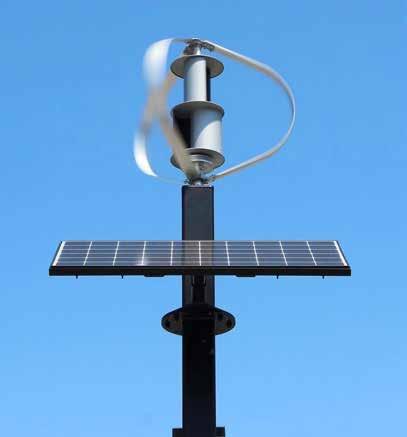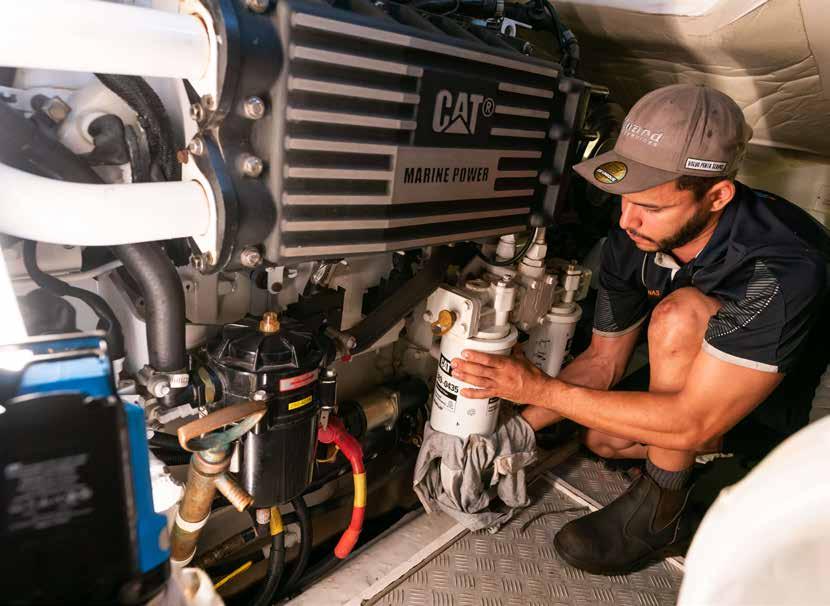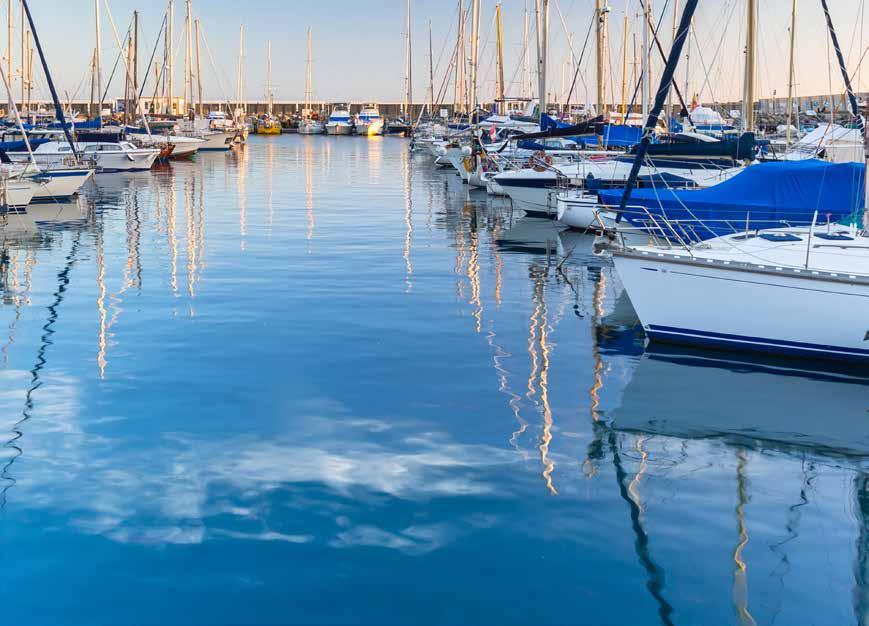
8 minute read
PREPARING THE FUTURE WORKFORCE: NAVIGATING SKILLS EVOLUTION IN AUSTRALIA’S MARINE INDUSTRY
by Tim Stackpool
The Australian marine industry stands at a technological crossroads. While traditional craftsmanship remains the backbone of worldclass vessel construction, emerging technologies are fundamentally reshaping the skills landscape.
From advanced composite manufacturing to AI-driven design systems, the sector faces a complex challenge: how to prepare a workforce that can seamlessly blend time-honoured marine trades with cutting-edge digital capabilities.
This evolution raises critical questions for our industry already grappling with recruitment challenges. Are we facing a simple skills shortage, or something more nuanced, perhaps a fundamental shift in what marine careers actually entail? The answer, according to industry leaders, is both.
The Technology Revolution Driving Change
The drivers of change in marine skills demand are various and accelerating. “The marine industry has been slowly changing over the last 10 years but the last five has seen the most change,” explains Brett Ambrosio, Executive Director of Education at the Australian Institute of Engineering. “Advanced Composite Techniques are transforming the marine skills demand. With more businesses investing in things like Vacuum Bagging & Infusion, Additive Manufacturing (3D Printing), Digital Design & Simulation as well as Robotics & Automation.”
At Riviera Australia, this technological transformation is tangible. Keira Badke, Apprentice & Training Manager, describes how “infusion, CNC, robotic systems, 5-axis routers and laser cutting” now form part of their production processes, requiring “a blend of traditional skills and computer literacy.” The company has adapted their training accordingly to bridge this gap between heritage craftsmanship and modern manufacturing.
From a broader industry perspective, Maria Hobbs, Marine Jobs Project Officer at the Boating Industry Association (BIA), identifies global competitiveness as a key driver. “Australian manufactured marine products and vessels are world leading in design and quality but labour in our country is expensive,” she notes.
Of course, environmental regulations add another layer of complexity. As governments worldwide tighten emissions standards and sustainability requirements, the marine sector must develop expertise in alternative fuels, electrification, and environmentally compliant manufacturing processes. The role of BIA is to engage with governments on changes to policy settings by regulators, especially in relation to decarbonisation and sustainability, to ensure policy makers make decisions informed by the boating industry.
Beyond the Skills Shortage Narrative
While we see headlines that consistently reference a “skills shortage” in the marine industry, the reality requires further investigation. “The marine industry is facing both a shortage and a shift in skills,” explains Badke. “While traditional boatbuilding craftsmanship remains the backbone of our industry, advances in automation, electrification and digital integration are creating demand for new technical competencies.”
Looking at the international context, Ambrosio notes “the marine industry is facing a critical shortage of skilled workers worldwide, driven by an ageing workforce, limited training capacity, and expanding demand for shipbuilding, offshore operations and vessel maintenance.” However, he emphasises the nature of roles is shifting at the same time, with businesses now requiring employees who have strong IT proficiency, data analytics and expertise in digital navigation, and alternative fuels, being skills not traditionally taught in maritime training programmes.
The BIA’s experience supports this dual challenge. Hobbs explains that “the marine industry has long been grappling with a skills shortage. Lack of awareness of the range of job opportunities has been an issue for a long time.
“Positively, the BIA has seen a significant uplift in people asking about marine industry jobs and careers. This is due to the Associations concerted effort to get out into the community and raise awareness”.
The recruitment challenge too extends beyond the numbers. “Businesses are struggling to recruit because of lack of qualified individuals,” notes Hobbs. “Many businesses also struggle with being able to devote the time required to train new recruits.” Past negative experiences with training programs may have created hesitancy among employers, although initiatives like the BIA’s “Marine Ready” pilot program aim to address these concerns by better preparing candidates.
BIA is encouraged by the great results which have been delivered and continue to be seen with its Marine Academy partnership with the Industry School. This initiative to deliver a pipeline of school based apprenticeships has been tested and proven to be successful, and has the ability to be delivered across the country.
Training and Education Response
Training organisations are certainly adapting but challenges remain. Ambrosio explains education providers can “meet bespoke business requirements despite the constraints of standardised training packages by adopting a structured, collaborative approach.” He says this involves analysing specific skill gaps, creatively packaging units, contextualising assessments and leveraging blended delivery models.
However, it appears systemic issues persist. Hobbs identifies a critical need for courses that directly relate to emerging and growing parts of the marine industry, while ensuring traditional courses now teach skills that align with modern manufacturing methods. Geographic barriers also compound these challenges, with significant need nationally for Registered Training Organisations (RTOs) to offer remote learning opportunities as travel and accommodation costs associated with learning are major factors when a young person is choosing their career path.
The availability of training providers for marine careers across metro and regional areas is a challenge. BIA believes the success of the industry includes remote learning options to support regional apprentices and businesses and for RTOs and TAFE to deliver marine courses based on the location of marine businesses in each region. Hobbs observes, “many young people at careers fairs and events express strong interest in joining our industry and working in marine trades and jobs. However, their enthusiasm decreases when they become aware of the limited options to study without relocation.”
In one industry case, Riviera has taken matter into its own hands. “Riviera has invested heavily in our apprenticeship program for over three decades and works closely with our current training providers to ensure apprentices receive practical, up to date skills that match the complexity of today’s motor yachts,” explains Badke. Their program “combines traditional craftsmanship with new technologies in electronics, diagnostics, and systems integration.”

The number of businesses however in Australia with the ability to achieve what Riviera has done is very limited. The BIA’s collaboration with the Industry School was established to support the majority of marine businesses that are not able to finance, resource and deliver a large-scale apprenticeship program and to make the process easier for all involved parties. Firstly, it provides potential employers with a great opportunity to have the ability to source trainees and apprentices from a pool of young people that have a genuine interest in working in the marine industry. Secondly, it provides an opportunity for young people to spend time in different trades to give them an informed choice of which trade pathway best suits their needs. The Industry School’s Marine Academy enables the chosen education provider to have confidence that there is a continuity of young people coming through to do their courses.
The BIA acts as a conduit to all participants and assists in growing the program through it’s network and membership base.
Business Perspectives on Workforce Development
Employers are actively adapting their strategies to attract and retain talent in a competitive market. “Businesses are having to offer incentives to attract and retain employees,” notes Hobbs. “All businesses are experiencing challenges with employee expectations and competing industries (construction, mining, etc.).”
The competition for apprentices is particularly intense. Ambrosio cites Australian Industry Group data showing “over 80% of employers say apprenticeships are ‘important or very important’ to their business.” He reports that businesses are actively competing for a limited pool of apprentices, with many reporting that finding suitable candidates is their biggest challenge.
Successful employers are now taking proactive approaches. “Employers need to be hands-on in shaping the future workforce,” emphasises Badke. Riviera’s strategy includes offering “one of Australia’s most comprehensive marine apprenticeship programs” while investing “significantly in upskilling of existing staff, ensuring knowledge is passed down while new skills are created.”
Partnership with training providers is crucial. Both BIA and Riviera work with RTOs who are willing to work closely with their training program to align course content with real-world expectations. Using this collaborative approach helps bridge the gap between standardised training packages and specific industry needs.
Attracting Career Changers
The marine industry’s appeal extends beyond traditional recruitment pools. “A significant percentage of the marine industry started their career in a different sector,” observes Hobbs. “Many have worked overseas in seafaring roles, in the superyacht sector, in mining and even in areas such as Defence, Police, etc.”
The primary attraction remains consistent across demographics. “Undoubtedly the number one attraction to our industry is getting the opportunity to work in, on or around our waterways,” Hobbs explains. Popular entry points include marine retail, boat sales, hospitality and tourism as well as marine engineering, marine craft construction and mechanical trades.



Career changers subsequently bring valuable perspectives and skills. “Mid-career entrants bring valuable experience, adaptability, and fresh perspectives,” notes Badke. The key to successful recruitment is “showcasing the variety of careers available, the global nature of the industry, and the satisfaction of building worldclass motor yachts.”
Ambrosio sees “growing momentum around attracting career changers into the marine sector, especially from industries like automotive, IT and construction. Many of these individuals bring highly transferable skills that can be adapted to boat building, marine systems and offshore operations.”
Support systems are essential for successful transitions, as Riviera’s approach emphasises: “clear pathways, on-the-job training, and strong mentoring” to make career changes smoother for mid-career professionals.
Future-Proofing the Marine Workforce
So looking ahead, the industry needs to emphasise strategic, collaborative approaches to workforce development. “The marine industry working together to actively promote job and career opportunities and to support initiatives is imperative to the industry’s future success,” argues Hobbs. This includes “participation and providing advice and if possible, opportunities for job seekers (work experience, traineeships, etc.)” to build the future talent pipeline.
Ambrosio advocates for change beyond reactive training. “The marine industry must move beyond reactive training and embrace a strategic, anticipatory approach. That means not just teaching today’s skills, but preparing for tomorrow’s challenges, including climate resilience, digital transformation, and global mobility. The key lies in collaboration, flexibility, and foresight.”
At the enterprise level, Riviera’s strategy focuses on maintaining “strong collaboration with schools, workforce programs, RTOs and industry bodies.” Badke emphasises the need to “anticipate skill needs early, embed emerging technologies into training and actively promote the marine sector as an exciting and sustainable career choice.”
The investment required will be significant but necessary. “Investing in apprenticeships, youth engagement, and lifelong learning is essential to ensure we meet global demand for Australian-built motor yachts for decades to come,” Badke says.
Charting the Course Forward
The Australian marine industry’s workforce challenges reflect broader trends affecting advanced manufacturing globally. Success requires acknowledging that traditional skills shortages have evolved into something more complex, that being a fundamental transformation in what marine careers entail.
The path forward will demand coordinated action across multiple fronts. Training providers must develop more flexible, responsive programs that combine heritage craftsmanship with emerging technologies. Employers must invest in comprehensive development programs while partnering closely with education providers. Industry bodies like the BIA, must continue promoting career opportunities while supporting initiatives that prepare “marine ready” candidates.
Perhaps most importantly, the industry must continue to embrace its unique selling proposition. The opportunity to “work in, on or around our waterways” while contributing to world-class Australian manufacturing provides a compelling career narrative, which is seen by the number of students attending ‘Career Day’ at various BIA boat shows. Combined with clear pathways, strong mentoring, and recognition of transferable skills from other industries, this appeal can help attract the diverse, skilled workforce the marine sector needs.
The convergence of traditional craftsmanship and advanced technology isn’t just changing what marine workers do, it’s expanding who can succeed in the industry. By embracing this evolution and investing in comprehensive workforce development, Australia’s recreational boating industry can ensure it has the skilled professionals needed to maintain its world-leading position in an increasingly competitive global market.






